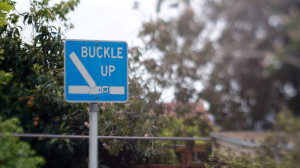Dispelling Myths About Seatbelts
By Daniel E DAngelo Esq on January 26, 2016
You may not hear it quite as often anymore – but it does still pop up in every day conversation. You’ll hear someone say, “You know, the only reason I survived my car crash is because I wasn’t wearing a seatbelt.” Or perhaps the even more bold, “it’s safer to ride without a seatbelt – they just make things worse.” Of course this is all absurd and you should wear your seat belt every time and all the time.
 The fact is, seatbelts save many lives. Unfortunately, motor vehicle crashes are the leading cause of death among Americans aged 1-54.[1] Hopefully, with trends like Moving Towards Zero Deaths in Colorado, and the advent driverless cars, this isn’t the case much longer. The CDC (Center for Disease Control and Prevention) asserts that seatbelts are the single most effective way to reduce injuries in a crash, but millions of Americans still drive and ride without wearing them.[2]
The fact is, seatbelts save many lives. Unfortunately, motor vehicle crashes are the leading cause of death among Americans aged 1-54.[1] Hopefully, with trends like Moving Towards Zero Deaths in Colorado, and the advent driverless cars, this isn’t the case much longer. The CDC (Center for Disease Control and Prevention) asserts that seatbelts are the single most effective way to reduce injuries in a crash, but millions of Americans still drive and ride without wearing them.[2]
This presents an interesting question. Why? Why do so many American adults avoid taking a minor step that could potentially save their life? It’s a difficult question to answer, but it must start with education. You hear various reasons why people don’t wear seatbelts – the safety myth only being one. Another reason some don’t wear them is comfort. They claim that driving or even riding in a car with a seatbelt on is just too uncomfortable. Yet another reason people don’t wear their seatbelts is simply forgetfulness – the importance of seatbelts just hasn’t been explained enough to them. All of these common objections can be overcome with education.
In 2012, more than half of the teenagers who died in a crash were not wearing a seatbelt. It’s estimated that adults aged 18-34 are the least likely group to wear seatbelts. Additionally, men fail to wear seatbelts at a higher rate than women.[3] It’s young people – predominantly men – who aren’t wearing seatbelts, so what can we do? Some of the seatbelt avoidance can be attributed to younger people’s penchant for risky behavior, but that doesn’t mean it can’t be curbed. It goes right back to education, the simple fact is that we must be more aggressive when educating people about the importance of wearing a seatbelt.
In the last decade, we’ve come a long way as a country. There are far-reaching campaigns like “Click It or Ticket” that encourage people to wear seatbelts every time they drive. There is one issue with this type of response however – punishing people for not wearing safety belts is negative reinforcement, something that has shown to be less successful that other methods. I favor an approach that informs and educates, rather than redresses. Reaching children at a young age, years before they ever drive, is essential. Simply talking isn’t enough though, demon it is important to highlight statistics and when appropriate, use images, which can be powerful learning lessons for young people.
It’s crucial that you and your family are wearing their seatbelts all the time. If you have children, teach them to wear them if they aren’t with you – even when the adults they with don’t! A collision may still injure you when you’re wearing a seatbelt, but your chances of surviving and minimizing those injuries are greatly increased when you’re wearing a seatbelt. Not wearing your seatbelt may also prevent you from recovering certain types of damages caused in a motor vehicle collision in Colorado even if the collision was not your fault, so buckle up. We want you to be safe on the road but if you are the victim of a car accident and would like to learn more about your rights, we are here to help. Don’t hesitate to give us a call or reach out online if you would like to discuss a recent incident. We do not charge for consultations by phone or in person.


